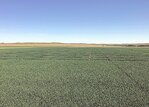South Dakota Extension forage field specialist
With mild conditions across the state for much of the winter, many producers have planted small grains already or will very soon; however, questions still remain as to whether the plants are at risk …
This item is available in full to subscribers.
To continue reading, you will need to either log in to your subscriber account, or purchase a new subscription.
If you are a current print subscriber, you can set up a free website account and connect your subscription to it by clicking here.
If you are a digital subscriber with an active, online-only subscription then you already have an account here. Just reset your password if you've not yet logged in to your account on this new site.
Otherwise, click here to view your options for subscribing.
Please log in to continue |



With mild conditions across the state for much of the winter, many producers have planted small grains already or will very soon; however, questions still remain as to whether the plants are at risk of damage from late winter storms/low air temperatures.
Small grains are some of the most frost tolerant crops we plant, but we still have to be mindful of soil and air temperatures when planting. The growing point of small grains does not emerge above the soil surface until jointing, after which time the crop is much more susceptible to frost damage than any time previous. Drought or several days of temperatures below 50°F can actually cause the plant to go through a hardening process, increasing frost tolerance. However, once the growing point emerges after jointing (when reproductive tissue is forming), detrimental losses could occur should temperatures drop. From boot to flowering, small grains are most sensitive to frost; temperatures under 28°F will cause moderate to severe injury depending upon growth stage and length of time low temperatures are sustained. There is no hard and fast planting rule involving air temperatures and small grains, but this year’s early planting dates may increase frost damage risk.
Still deciding when to plant? To determine the best window to plant small grains, begin by monitoring three-day average soil temperatures in the early spring. A great reference for soil temperature in your area is the SD Mesonet network.
This growing weather station network measures soil temperature at five depths in several locations throughout South Dakota. Although our small grain planting depths can be quite shallow, the agricultural engineering standard for environmental observations is at a 4-inch soil depth under bare soils, making this measurement the one to rely on for planting-related soil temperature data (current agronomic recommendations take the difference in depth into account). The Mesonet site provides daily averages based on 10-minute incremental updates. To check out statewide soil temperature date, visit https://climate.sdstate.edu/ and click the ‘Archive’ button at the top. From there choose ‘State Maps’ and then select the ‘Soil Temp, 4” Bare’ layer on the map; this will allow you to view the most recent data and look back at previous days as well. To view recent soil temperature data for an individual station, go to ‘Current’ and then select ‘Local Data’. Selecting a station will lead you to the current observations for that location. Once you are viewing a single station, you can choose the tab for ‘History’ to see the last seven days of measurements by choosing the ‘7-day Table’. This is sometimes easier to view for a quick overview of recent soil temperatures. See Table 1 for specific information on the germination temperatures of common spring-seeded South Dakota crops.
The ideal South Dakota spring planting window for small grains like wheat and oats is typically accepted as the first three weeks of April or earlier if conditions are favorable. In years like this, we likely will worry about plants freezing off if planted a bit too early; however, late planted small grains are more prone to heat and water stress, which can be very hard on these plants as they develop as well (especially during pollination and grain fill).